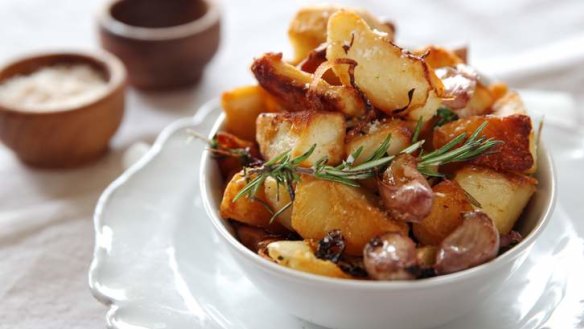Know your spuds
Mash, fry or bake: how to make the most out of everyone's favourite tuber.

We adore autumn's figs, the first young peas of spring, and summer heirloom tomatoes. Come winter, many of us eschew Peruvian asparagus and Mexican mangoes, preferring to wait until the Australian versions come into season.
But potatoes? It's easy to forget spuds have seasons too, and are most delicious when they are freshly harvested.
''We plant in spring, grow in summer and harvest in autumn,'' says pioneering specialist grower Geoff Dobson, of Dobson's Potatoes in Alexandra, Victoria.
Australia has a range of potato-friendly climate zones, from Queensland to Tasmania, all with different growing seasons. Happily, that means we can buy recently harvested potatoes year round.
While almost 60 per cent of Australian potatoes are grown for processing, mostly into frozen products, the 40 per cent sold fresh are far more diverse than in the past.
In the 1980s, potatoes were rarely sold by variety. Dobson recalls that when he grew his first waxy, yellow patrones 30 years ago, people didn't know what to do with them.
Since then, varieties such as the hugely popular pink, creamy-fleshed desiree, smooth-textured dutch creams and the slender, yellow kipfler have found places in supermarkets. Although all potato varieties hail from the same botanical family, like siblings, they are capable of behaving very differently.
Broadly speaking, they fall into two main categories, with flesh that is either floury or waxy in texture when cooked. In his encyclopaedia of kitchen science, McGee on Food and Cooking, US writer Harold McGee explains that floury potatoes are denser and have more dry starch in their cells. During cooking, they separate and become dry and fluffy. Cells in waxy varieties stick together when cooked, helping them to remain in firm, intact pieces for dishes such as gratins or salads.
Chips
General-purpose sebagos are popular with chefs for making chips. At Melbourne's one-hat Merricote restaurant in Northcote, co-owner and chef Rob Kabboord uses sebagos for triple-cooked chips. Richie Dolan, head chef at Woollahra's Chiswick restaurant in Sydney, also chooses sebagos to make fat chips and roast potatoes. At Sydney newcomer Sagra in Darlinghurst, owner-chef Nigel Ward uses creamy white-fleshed King Edwards to make thrice-cooked rosemary potatoes.
Gnocchi
Ward may use dutch creams, but he prefers desirees (also Dolan's choice) for gnocchi.
''The skin is a bit thicker, so it's less likely to split when you're cooking them,'' he says.
Oliver Gould, head chef at Melbourne's Stokehouse, also favours desirees, baking them on rock salt until they are soft.
''Supreme gnocchi requires minimal moisture for light texture,'' he says.
Potato salad
Waxy varieties, often with Dutch origins, loom large in chefs' salad preferences. Gould uses nicolas, while Kabboord likes bintjes in a salad with mackerel and egg yolk. Dolan prefers kipflers, originally from Austria.
Mashing
When it comes to mashing, opinion is divided. Gould, along with many home cooks, likes sebagos. These floury potatoes are easy to break up and give a light, fluffy result.
Why do so many professionals nominate waxy varieties? It's all in the cell structures, writes McGee, and in the cook's preferred style of mash.
Boiled floury potatoes readily absorb butter, milk or cream. Waxy varieties require more effort to force them to take up liquid, but can absorb lavish quantities of butter, making the kind of decadently rich classic French puree often found in restaurants.
Kabboord uses waxy Dutch creams, nicolas or bintjes: ''We do a Parisian mash, equal quantities butter and potato.''
Selection and storage
● Be choosy, says specialist grower Geoff Dobson. Choose firm spuds and don't buy ones with obvious dark or soft patches, insect or mechanical damage, such as big cuts, or green skins.
● Handle with care. Potatoes look tough, but can and do bruise.
● Keep potatoes in a well-ventilated, cool, dark environment. ''Even after potatoes are harvested, they continue to be living organisms,'' says AUSVEG spokesman Luke Raggatt. Warmth encourages sprouting. Prolonged light exposure causes them to turn green, which tastes bitter and, in large quantities, can be toxic.
● Use paper bags, as plastic can get sweaty.
● Don't store uncooked spuds in the fridge. Very low temperatures can convert potato starches to sugars, causing fried or roast potatoes to brown too quickly.
Boil 'em, mash 'em, stick 'em in a stew
These are just some varieties: there are hundreds. If you can't find a specific variety in the shops, the important distinction is floury versus waxy. White-fleshed, floury potatoes fry and roast well. Yellow-fleshed, waxy ones are better for salads, gratin or curries. If you are looking for a crunchy finish from a waxy potato, it can help to partly cook (boil or bake in the jacket), before slicing for frying or roasting.
New potatoes are not a variety, just potatoes that have been harvested early while the skins are still tender and papery. White or yellow-fleshed, these very young potatoes tend to waxiness and should be cooked soon after harvesting, because they deteriorate quickly. Simply simmer them in their skins or steam. Serve with a little butter or olive oil and salt and maybe a scattering of chopped soft herbs.
The best recipes from Australia's leading chefs straight to your inbox.
Sign upFrom our partners
Original URL: https://www.theage.com.au/link/follow-20170101-38443